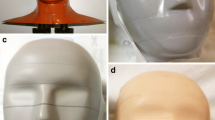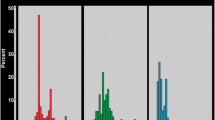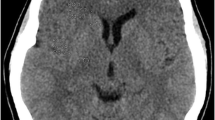Abstract
In this chapter an overview is given of different modalities for dose optimization and reduction in cranial CT and CT of the Head and Neck region. For adult cranial CT, the role of the justification process and the implementation of the use of imaging guidelines are discussed. Possibilities for dose reduction by use of diagnostic reference levels (RDLs) and the introduction of recent dose reduction techniques, like tube current modulation and iterative reconstruction, are overviewed. A separate part is dedicated to dose reduction in cranial CT of children. In the Head and Neck region, the main topics are use of low dose CT of the sinuses in adults and children and the recent introduction of cone beam CT as a low-dose alternative for conventional CT.
Access this chapter
Tax calculation will be finalised at checkout
Purchases are for personal use only
Similar content being viewed by others
References
Brain CT:
American College of Radiology, Appropriateness Criteria for imaging (2011). www.acr.org/SecondaryMainMenuCategories/quality_safety/app_criteria.aspx
Boone JM, Geraghty EM, Seibert JA et al (2003) Dose reduction in pediatric CT: a rational approach. Radiology 228:352–360
Brisse H, Aubert B (2009) CT exposure from pediatric MDCT: results from the 2007–2008 SFIPP/IRSN survey. J Radiol 90:207–215
Britten AJ, Crotty M, Kiremidjian H et al (2004) The addition of computer simulated noise to investigate radiation dose and image quality in images with spatial correlation of statistical noise: an example application to X-ray CT of the brain. Br J Radiol 77:323–328
Brenner DJ, Elliston CD, Hall EJ et al (2001) Estimated risks of radiation-induced fatal cancer from pediatric CT. Am J Roentgenol 176:289–296
Buls N, Bosmans H, Mommaert C et al (2009) Current status on pediatric CT doses: a multicentre study (Belgium). RSNA meeting, Chicago. www.fanc.fgov.be/cws/GED/pop_View.aspx?LG=1&ID=2449
Chan CY, Wong YC, Yu SK et al (1999) Radiation dose reduction in paediatric cranial CT. Pediatr Radiol 29:770–775
Clark J, Cranley K, Robinson J et al (2000) Application of draft European Commission reference levels to a regional CT dose survey. Br J Radiol 73:43–50
Clarke JC, Cranley K, Kelly BE et al (2001) Provision of MRI can significantly reduce CT collective radiation dose. Br J Radiol 74:926–931
Cohnen M, Fisher H, Hamacher J et al (2000) CT of the head by use of reduced current and kilovoltage: relationship between image quality and dose reduction. Am J Neuroradiol 21:1654–1660
European Community (1998) Quality criteria for computed tomography. EC working document EUR 16262, Brussels, EU, 1998
European Commission: Radiation protection 118. Referral guidelines for imaging. Office for Official Publications of the European Communities, Luxembourg, 2008. www.ec.europa.eu/energy/nuclear/radioprotection/publications/doc/118_en.pdf
Fearon T, Vucich J (1987) Normalized pediatric organ-absorbed doses from CT examinations. Am J Roentgenol 148:171–174
Fox AJ (2004) Use of the lowest necessary radiation dose (editorial). Am J Neuroradiol 25:519
Galanski M, Nagel HD, Stamm G (2007) Paediatric CT exposure practice in the federal republic of Germany: results of a nationwide survey in 2005–2006. Medizinische Hochschule, Hannover
Gündogdu S, Mahmutyazicioglu K, Ozdemir H et al (2005) Assessment of image quality of a standard and three dose-reducing protocols in adult cranial CT. Eur Radiol 5:1959–1968
Hart D, Wall BF (2004) UK population dose from medical X-ray examinations. Eur Radiol 50:285–291
Hall EJ, Brenner DJ (2008) Cancer risks from diagnostic radiology. Br J Radiol 81:362–378
Hidajat N, Wolf M, Nunnemann A et al (2001) Survey of conventional and spiral CT doses. Radiology 129:395–401
Hiles PA, Brennen SE, Scott SA et al (2001) A survey of patient dose and image quality for computed tomography in Wales. J Radiol Prot 21:345–354
Huda W, Atherton JV, Ware DA et al (1997) An approach for the estimation of effective radiation dose at CT in pediatric patients. Radiology 203:417–422
International Commission on Radiological Protection (1991) Recommendations of the International Commission on Radiological Protection. ICRP report 60. Annals of the ICRP, 21 (1–3), 1991
Kalra MK, Maher MM, Toth TL et al (2004a) Techniques and applications of automatic tube current modulation. Radiology 233:649–657
Kilic K, Erbas G, Guryldirim M et al (2011) Lowering the dose in head CT using adaptive statistical iterative reconstruction. Am J Neuroradiol, Epub, 11 August 2011, 10.3174/ajnr.A2585
Leipsic J, LaBounty TM, Heilbron B et al (2010) Adaptive statistical iterative reconstruction: assessment of image noise and image quality in coronary CT angiography. Am J Roentgenol 195:649–654
McCrohan JL, Patterson IF, Gagne RM et al (1987) Average radiation doses in standard head examination for 250 CT systems. Radiology 163:263–268
Mullins ME, Lev MH, Bove P et al (2004) Comparison of image quality between conventional and low-dose nonenhanced head CT. Am J Neuroradiol 25:533–538
Oikarinen H, Meriläinen S, Pääkö E et al (2009) Unjustified CT examinations in young patients. Eur Radiol 19:1161–1165
Pantos I, Thalassinou S, Argentos S et al (2011) Adult patient radiation doses from non-cardiac CT examinations: a review of published results. Br J Radiol 84:293–303
Rehani MM, Berry M (2000) Radiation doses in computed tomography. Br Med J 320:593–594
Rogers LF (2001) Taking care of children: check out the parameters used for helical CT (editorial). Am J Roentgenol 176:287
Royal College of Radiologists, UK, Referral guidelines (2011). www.rcr.ac.uk/content.aspx?PageID=955
Shah R, Gupta AK, Rehani MM et al (2005) Effect of reduction in tube current on reader confidence in paediatric computed tomography. Clin Radiol 60:224–231
Shrimpton PC, Jones DG, Hillier MC et al (1991) Survey of CT practice in the UK, NRPB-R249 report. National Radiological Protection Board (NRPB), Chilton, UK
Shrimpton PC, Hillier MC, Lewis MA et al (2005) Dose from CT examination in the UK-2003 review. NRPB-W67 Report. National Radiological Protection Board, Chilton
Silkoset RD, Lysdahl KB, Olerud HM (2010) Variations in doses from CT examinations, presented at: European Congress of Radiology, Vienna
Silva AC, Lawder HJ, Hara A et al (2010) Innovations in CT dose reduction strategy: application of the adaptive statistical iterative reconstruction algorithm. Am J Roentgenol 194:191–199
Smith AB, Dillon WP, Lau BC et al (2008) Radiation dose reduction strategy for CT protocols: successful implementation in neuroradiology section. Radiology 247:499–506
Stamm G (2007) Collective radiation dose from MDCT: critical review of survey studies. In: Radiation dose from adult and pediatric multidetector computed tomography, 1st edn. Springer, Berlin-Heidelberg, pp 81–97
Tsapaki V, Aldrich JE, Sharma R et al (2006) Dose reduction in CT while maintaining diagnostic confidence: Diagnostic reference levels at routine head, chest and abdominal CT–IAEA-coordinated research project. Radiology 240:828–834
Van Unnik J, Broerse JJ, Geleijns J et al (1997) Survey of CT techniques and absorbed dose in various Dutch hospitals. Br J Radiol 70:367–371
Veit R, Guggenberger R, Nosske D et al (2010) Diagnostische referenzwerte für röntgenuntersuchungen. Radiologe 50:907–912
Verdun FR, Gutierrez D, Vader JO et al (2008) CT radiation dose in children: a survey to establish age-based diagnostic reference levels in Switzerland. Eur Radiol 18:1980–1986
Wong ETH, Yu SK, Lai M et al (2001) MAPD–an objective way to select mAs for paediatric brain CT. Br J Radiol 74:932–937
Yeoman LJ, Howarth L, Britten A et al (1992) Gantry angulation in brain CT: dosage implications, effect on posterior fossa artifacts, and current international practice. Radiology 184:113–116
Zacharia TT, Kanekar SG, Nguyen DT et al (2011) Optimization of patient dose and image quality with z-axis dose modulation for computed tomography (CT) in head trauma and stroke. Emerg Radiol 18:103–107
Zwirewich CV, Mayo JR, Müller NL (1991) Low-dose high resolution CT of lung parenchyma. Radiology 180:413–417
Head and Neck CT
American Academy of Pediatrics (no authors listed) (2001) Subcommittee on management of sinusitis and Committee on quality improvement: clinical practice guideline: management of sinusitis. Pediatrics 108:798–808
Bulla S, Blanke P, Hassepass F et al (2011) Reducing the radiation dose for low-dose CT of the paranasal sinuses using iterative reconstruction: feasibility and image quality. Eur J Radiol, EPub June 8, 2011, doi 10.1016/e.ejrad.2011.05.002
Czechowski J, Janeczek J, Kelly G et al (2001) Radiation dose to the lens in sequential and spiral CT of facial bones and sinuses. Eur Radiol 11:711–713
Duvoisin B, Landry M, Chapuis et al (1991) Low-dose CT and inflammatory disease of the paranasal sinuses. Neuroradiology 33:403–406
Eggesbö HB (2006) Radiological imaging of inflammatory lesions in the nasal cavity and paranasal sinuses. Eur Radiol 16:872–888
George P, Huges J (1990) Respiratory system. In: Summitt (ed) Comprehensive pediatrics, Mosby
Glasier CM, Mallory GB, Steele RW (1989) Significance of opacification of the maxillary and ethmoid sinuses in infants. J Pediatr 114:45–50
Gordts F, Clement PA, Destryker A et al (1997) Prevalence of sinusitis signs on MRI in a non-ENT pediatric population. Rhinology 35:154–157
Greess H, Lutze J, Nomayr A et al (2004) Dose reduction in subsecond multislice spiral CT examination of children by online tube current modulation. Eur Raadiol 14:995–999
Hagtvedt T, Aalokken TM, Notthellen J et al (2003) A new low-dose CT examination compared with standard-dose CT in the diagnosis of acute sinusitis. Eur Radiol 13:976–980
Hein E, Rogalla P, Klingebiel R et al (2002) Low-dose CT of the paranasal sinuses with eye lens protection: effect on image quality and radiation dose. Eur Radiol 12:1693–1696
Hodez C, Griffaton-Taillandier C, Bensimon I (2011) Cone-beam imaging: applications in ENT. Eur Ann Otorhinolaryngol Head Neck Dis 128:65–78
Kalra MK, Maher MM, Toth TL et al (2004b) Techniques and applications of automatic tube current modulation. Radiology 233:649–657
Kearny SE, Jones P, Meakin K et al (1997) CT scanning of the paranasal sinuses–the effect of reducing mAs. Br J Radiol 70:1071–1074
Kronemer KA, McAlister WH (1997) Sinusitis and its imaging in the pediatric population. Pediatr Radiol 27:837–846
Loubele M, Jacobs R, Maes F et al (2005) Radiation dose vs. image quality for low-dose CT protocols of the head for maxillofacial surgery and oral implant imaging. Radiat Prot Dosimetry 117:211–216
Loubele M, Bogaerts R, Van Dijck E et al (2009) Comparison between effective radiation dose of CBCT and MSCT scanners for dentomaxillofacial applications. Eur J Radiol 71:461–468
Marmolya G, Wiesen EJ, Yagan R et al (1991) Paranasal sinuses: low-dose CT. Radiology 181:689–691
McAlister WH, Lusk R, Muntz HR (1989) Comparison of plain radiographs and coronal CT scan in infants and children. Am J Roentgenol 153:1259–1264
McAlister WH, Parker BR, Kushner DC et al (2000) Sinusitis in the pediatric population. American College of Radiology. ACR Appropriateness Criteria, 1999. Radiology 215:811–818
McCollough CH, Bruesewitz RT, Kofler JM (2006) CT dose reduction and dose management tools: overview of available options. Radiographics 26:503–512
Miracle AC, Mukerji SK (2008a) Conebeam CT of the head and neck, part 2: clinical applications. Am J Neuroradiol 30:1088–1095
Miracle AC, Mukerji SK (2008b) Conebeam CT of the head and neck, part 2: clinical applications. Am J Neuroradiol 30:1285–1292
Mulkens TH, Broers C, Fieuws S et al (2005a) Comparison of effective doses for low-dose MDCT and radiographic examination of sinuses in children. Am J Roentgenol 184:1611–1618
Mulkens TH, Bellinck P, Baeyaert M et al (2005b) Use of an automatic exposure control mechanism for dose optimization in multidetector-row CT examinations: clinical evaluation. Radiology 237:213–223
Nauer CB, Eichenberger A, Dupach B et al (2011) CT radiation dose for computer-assisted endoscopic sinus surgery: dose survey and determination of dose-reduction limits. Am J Neuroradiol 30:617–622
Pauwels R, Beinsberger J, Collaert B et al (2011) Effective dose range of cone beam computed tomography scanners. Eur J Radiol doi:10.1016/ejrad.2010.11.028
Rao VM, El-Noueam KI (1998) Sinonasal imaging. Anatomy and pathology. Radiol Clin North Am 36:921–939
Robb RA (1982) The dynamic spatial reconstructor: an X-ray video-fluoroscopic CT scanner for dynamic volume imaging of moving organs. IEEE Trans Med Imaging 1:22–33
Ruivo J, Mermuys K, Bacher K et al (2009) Cone beam computed tomography, a low-dose imaging technique in the postoperative assessment of cochlear implantation. Otol Neurotol 30:299–303
Rustemeyer P, Streubuhr U, Suttmoeller J (2004) Low-dose dental computed tomography: significant dose reduction without loss of image quality. Acta Radiol 45:847–853
Schell B, Bauer RW, Lehnert T et al (2011) Low-dose computed tomography of the paranasal sinus and facial skull using a high-pitch dual-source system–fist clinical results. Eur Radiol 21:107–112
Shrimpton PC, Jones DG, Hillier MC et al (1991) Survey of CT practice in the UK, NRPB-R249 report. National Radiological Protection Board (NRPB), Chilton, UK
Sohaib SA, Peppercorn PD, Horrocks JA et al (2001) The effect of decreasing mAs on image quality and patient dose in sinus CT. Br J Radiol 74:157–161
Suojanen JN, Regan F (1995) Spiral CT scanning of the paranasal sinuses. Am J Neuroradiol 16:787–789
Tack D, Widelec J, De Maertelaer V et al (2003) Comparison between low-dose and standard-dose multidetector CT in patients with suspected chronic sinusitis. Am J Roentgenol 181:939–944
Vandenberghe B, Jacobs R, Bosmans H (2010) Modern dental imaging: a review of the current technology and clinical applications in dental practice. Eur Radiol 20:2637–2655
Zinreich SJ, Benson ML, Oliveiro PJ (1996) Sinusonasal cavities: CT normal anatomy, imaging of the osteomeatal complex, and functional endoscopic sinus surgery. In: Harnsberger HR (ed) Head and neck imaging, 3rd edn. St.Louis, Mosby
Author information
Authors and Affiliations
Corresponding author
Editor information
Editors and Affiliations
Rights and permissions
Copyright information
© 2011 Springer-Verlag Berlin Heidelberg
About this chapter
Cite this chapter
Mulkens, T., Salgado, R., Bellinck, P. (2011). Dose Optimization and Reduction in CT of the Brain and Head and Neck Region. In: Tack, D., Kalra, M., Gevenois, P. (eds) Radiation Dose from Multidetector CT. Medical Radiology(). Springer, Berlin, Heidelberg. https://doi.org/10.1007/174_2011_451
Download citation
DOI: https://doi.org/10.1007/174_2011_451
Publisher Name: Springer, Berlin, Heidelberg
Print ISBN: 978-3-642-24534-3
Online ISBN: 978-3-642-24535-0
eBook Packages: MedicineMedicine (R0)




